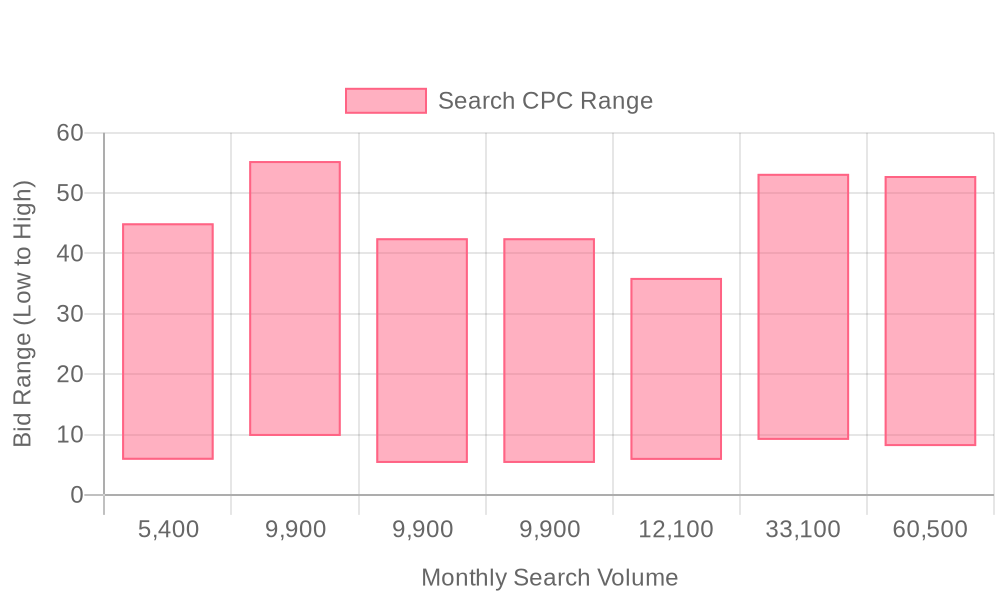
Supercharge your lead generation with a FREE Google Ads audit - no strings attached! See how you can generate more and higher quality leads
Get My Free Google Ads AuditFree consultation

No commitment
Supercharge your lead generation with a FREE LinkedIn Ads audit - no strings attached! See how you can generate more and higher quality leads
Get My Free Google Ads AuditFree consultation

No commitment
Supercharge your lead generation with a FREE Meta Ads audit - no strings attached! See how you can generate more and higher quality leads
Get My Free Google Ads AuditGet My Free LinkedIn Ads AuditGet My Free Meta Ads AuditFree consultation

No commitment
Supercharge your lead generation with a FREE Google Ads audit - no strings attached! See how you can generate more and higher quality leads
Get My Free Google Ads AuditFree consultation

No commitment
In today's complex marketing landscape, effective B2B marketing requires a strategic mix of both online and offline channels working in concert. Google Ads for Siding Contractors represents a powerful opportunity to bridge these efforts and engage your audience at critical moments. However, challenges such as incomplete account data can hamper personalization efforts, leading to missed segmentation or targeting opportunities. Modern solutions now allow businesses to overcome these barriers by enriching existing data for precise audience targeting. By intercepting decision-makers at the precise moment of need and measuring ROI from click to closed deal, you can ensure the effectiveness of your entire marketing ecosystem. This guide will help you harness the power of Google Ads to target with precision, optimize performance, and connect digital and offline marketing touchpoints.

Siding contractors can unlock high-intent lead generation by leveraging Google Ads with data-driven segmentation, precision targeting, and creative alignment tailored to home improvement buyers. When strategies are crafted around nuanced keyword selection, dynamic audience building, and real-time performance measurement, campaigns consistently outperform generic digital marketing for siding contractors in cost-per-lead and conversion rates.
This step-by-step guide provides a framework for maximizing qualified siding leads through Google Ads. It covers granular keyword strategies to limit wasted spend, creative and landing page best practices, advanced tracking for full ROI visibility, and cross-channel audience integration to drive conversions throughout the sales funnel.

Google Ads provides siding contractors with the unique ability to engage decision-makers exactly when they signal intent, driving measurable impact on lead quality and project pipeline. By leveraging advanced segmentation, digital marketing for siding contractors becomes more precise, enabling teams to focus efforts on high-potential accounts instead of generic, low-value inquiries. BuildBook’s guide on Google Ads provides a practical overview of how paid search can drive targeted leads for home improvement services.
Overcoming the generic analytics trap is essential for any contractor PPC campaign seeking to optimize ROI. With account-level insight, B2B teams can prioritize sales follow-up based on true engagement and company fit, rather than relying on surface-level metrics like anonymous clicks or impressions. This clarity ensures that resources are directed toward opportunities with the highest likelihood of closing, and that marketing and sales teams are always aligned on what matters most.
Specialized audience targeting is a cornerstone of effective Google Ads for siding contractors. Rather than taking a one-size-fits-all approach, B2B marketers can build dynamic audiences that evolve as prospects interact with ads, visit landing pages, or request estimates. Integration with platforms like Sona allows these audiences to refresh in real time, enabling campaigns to automatically shift focus toward the most engaged and conversion-ready accounts as they move through the funnel.
Capturing high-value projects requires industry-specific targeting that goes beyond broad geographies or generic job types. Using intent data, contractors can direct budget toward homeowners or property managers actively searching for services like "fiber cement siding replacement" or "vinyl siding repair near me." Real-time signals identify which prospects are truly in-market, helping teams seize immediate demand and preventing wasted spend on low-probability clicks.
Immediate demand response is vital in competitive markets, where timing can be the difference between winning and losing a lucrative siding contract. Google Ads gives contractors the flexibility to launch, pause, or adjust campaigns in response to changing market conditions, weather events, or seasonal peaks. With Sona, marketers can automate budget allocation based on spikes in high-intent traffic, ensuring coverage when it matters most.
Expanding into new regions becomes a data-driven exercise rather than guesswork. By analyzing campaign performance at the ZIP code or neighborhood level, siding companies can identify emerging demand pockets, optimize geo-targeting, and tailor messaging to local pain points. FatCat Strategies’ case study shares how geo-targeted ads can lower cost-per-lead while driving quality opportunities.
Integrated data analysis underpins closed-loop measurement for every contractor PPC campaign. Instead of losing visibility once a lead picks up the phone or schedules an in-person demo, advanced tracking ties online and offline actions back to the original ad and keyword. Platforms like Sona.Google Ads ROAS.

A strategic approach to Google Ads for siding contractors helps revenue teams capture high-intent demand, reinforce brand presence, and turn engaged prospects into qualified leads. Each campaign format targets a distinct stage of the buyer journey, enabling precise budget allocation and measurable results. The following campaign types are essential for a comprehensive, data-driven contractor PPC strategy. For a deeper dive into campaign structure, see this Google Ads guide for contractors tailored to home service professionals.

Siding contractors benefit most when they expand beyond the saturated basics of digital marketing and uncover untapped demand within their target markets. The most ambitious revenue teams take a data-driven approach to identify specialized segments, capture in-market intent, and orchestrate cross-channel engagement that translates to higher quality leads and increased conversion rates.
Growth-focused siding contractors who invest in these advanced tactics consistently outperform competitors by connecting marketing spend to revenue outcomes, uncovering new pockets of demand, and ensuring every ad dollar works toward measurable business goals. To see how these approaches can fit your business, book a demo and explore tailored solutions for your team.

Siding contractors who leverage audience segmentation consistently outperform those relying on broad targeting. By breaking down their audiences into smaller, actionable groups, they achieve higher conversion rates, more efficient ad spend, and a streamlined sales process that delivers measurable ROI.
Precision in segmentation enables contractors to engage each prospect based on project type, stage, and intent. This approach transforms anonymous website visits into known, high-value opportunities, allowing sales and marketing teams to prioritize leads that are most likely to convert. Tools like Sona help contractors identify and segment these audiences to maximize lead quality and campaign impact.
Layering intent signals on top of basic segmentation sharpens targeting even further. Differentiating between prospects seeking repair services versus full installation is critical, as their urgency, budget, and timeline expectations diverge. Firmographic overlays—such as company size or property age—add another layer of precision, allowing marketers to prioritize outreach to high-value commercial targets or aging residential properties. When real-time in-market behavior is integrated, contractors can dynamically reallocate budget toward segments demonstrating the highest purchase intent, resulting in increased lead quality and reduced acquisition cost.
Optimizing ad groups for each segment ensures creative and budget align with the specific needs of the audience. For example, campaigns targeting commercial renovations can showcase compliance credentials and large-scale project experience, while residential repair ads highlight local testimonials and fast response times. As leads engage, dynamic audience updates ensure prospects are shifted into the most relevant campaigns, increasing the likelihood of conversion. For actionable tactics on aligning ad groups with buying stages, see our guide on buying stage segmentation.
With seamless synchronization between CRM and ad platforms, enriched lead profiles flow directly into active Google Ads ad groups, supporting precise retargeting and nurturing at every stage.
A segmented approach only delivers results when conversion paths are fully validated and measurable. Integrating Google Ads data with CRM systems uncovers which segments are generating revenue and which require optimization. Advanced attribution connects online inquiries, phone calls, and even offline consultations back to the original ad and segment, providing a comprehensive view of ROI. Periscope Media benchmarks shares industry benchmarks for contractors optimizing Google Ads bidding strategies.
This closed-loop insight empowers siding contractors to continually refine their targeting, reallocate spend to top-performing segments, and scale campaigns that drive the highest business impact.
Ready to enhance your segmentation strategy? Start your onboarding and see how advanced segmentation can transform your results.

| Industry | Keyword | Monthly Search Volume | Competition Level | Low Bid | High Bid |
| Siding Contractors | siding installers near me | 5400 | MEDIUM | 5.82 | 45 |
| Siding Contractors | siding companies | 9900 | LOW | 9.77 | 55.32 |
| Siding Contractors | vinyl siding contractors near me | 9900 | MEDIUM | 5.29 | 42.52 |
| Siding Contractors | vinyl siding installers near me | 9900 | MEDIUM | 5.29 | 42.52 |
| Siding Contractors | siding repair near me | 12100 | MEDIUM | 5.8 | 35.95 |
| Siding Contractors | siding contractors | 33100 | LOW | 9.12 | 53.2 |
| Siding Contractors | siding companies near me | 60500 | MEDIUM | 8.09 | 52.84 |
A targeted keyword strategy for Google Ads for siding contractors is foundational to maximizing lead quality and campaign ROI. High-performing contractors consistently outpace their competitors by deploying precise, intent-driven terms that anticipate homeowner search behavior and local market nuances.
Precision in keyword strategy is critical for successful Google Ads for siding contractors. Start by clustering keywords according to service type, such as "vinyl siding installation," "fiber cement siding replacement," or "emergency siding repair." This segmentation ensures each campaign or ad group is closely aligned with specific service offerings, driving more relevant clicks from homeowners searching for those solutions. Industry-specific terms, like "James Hardie siding contractors," further refine targeting and capture higher-intent audiences.
Localizing keywords with precise geographic modifiers enhances regional relevance. Include city names, ZIP codes, and neighborhood references to attract homeowners in target service areas. For example, "siding contractors in Naperville" or "Denver storm-damage siding repair" narrows your reach to the most lucrative local opportunities. Keyword ideas for siding contractors provides a useful reference for keywords tailored to siding contractors.
Incorporate long-tail and question-based queries—such as "how much does siding replacement cost in Austin?"—to engage prospects with detailed intent. With unified data management, marketers can leverage historical lead quality, identifying which keywords correlate to the highest-value conversions and dynamically updating target lists as new trends emerge. This approach maximizes both efficiency and campaign ROI.
Effective ad copy addresses the core pain points of homeowners while tailoring messaging to each audience segment. Highlight urgent needs, such as weather-related damage or aging exteriors, with phrases like "Fast siding repairs before the next storm" or "Protect your home with expert siding installation." Use trust markers in headlines and descriptions, referencing years in business, certifications, or verified review counts, to build immediate credibility. Ad extensions—including callouts about "Free Estimates" or structured snippets listing available services—reinforce trust and drive higher engagement.
During seasonal peaks or after local storms, promote urgency through limited-time offers or same-day appointment options. Messaging can be dynamically adjusted as real-time intent signals reveal shifts in homeowner priorities, ensuring that budget and creative are always focused on high-converting audiences. Sophisticated platforms allow revenue teams to sync CRM and prospect data, updating audience segments and message variants automatically as leads progress through the funnel. Sona helps teams update and refine audience segments for more effective ad personalization.
This ensures every ad impression is as personalized and relevant as possible, increasing click-through and conversion rates.
Every landing page must deliver a seamless experience that matches the promise of the ad. Ensure a 1:1 alignment between ad copy and landing page content—if an ad highlights "James Hardie siding replacement in Dallas," then the landing page should feature local project photos, testimonials, and detailed information about that specific service. This tight alignment reduces friction, increases trust, and improves quality scores, lowering cost-per-click over time.
Conversion elements need to be thoughtfully designed for each audience segment. For high-intent visitors, a straightforward form requesting only essential contact details encourages quick action. For prospects still considering options, offer downloadable guides, financing calculators, or instant quote tools to increase engagement. Integrate real-time visitor identification, allowing marketers to personalize page elements for returning users or known accounts, further raising conversion potential. This builds on the strategies outlined in the website visitor intelligence guide.
Offline interactions—such as phone calls or showroom visits—can be tracked and attributed alongside online submissions, providing a holistic view of campaign performance and enabling continuous optimization.
Continuous optimization is essential for sustained success with Google Ads for siding contractors. Smart bidding strategies, such as automated Target CPA or ROAS, adjust bids in real time based on conversion data and audience behavior. These tactics allocate more budget to keywords and locations generating the highest-value leads, maximizing efficiency during peak demand periods or in specific geographies.
A/B testing should be routine, with headline, description, and call-to-action variants evaluated against clear performance benchmarks. Bidding strategies for contractors provides a deeper look at optimal bidding strategies for contractors.
As new insights emerge—such as which offer or message drives the most inquiries—creative assets and targeting parameters are refined. By integrating offline conversion data, like closed deals from phone calls or in-person estimates, marketers gain a comprehensive view of actual ROI, not just lead volume. When CRM and ad platforms are fully synchronized, enriched contact and account data can be pushed directly into ad audiences, powering dynamic retargeting and lookalike modeling. This data-driven feedback loop ensures campaigns are always evolving to capture the best possible results and drive sustainable growth in siding leads.
Expanding your siding contractor presence requires more than running isolated campaigns: it takes a connected, insight-driven approach that aligns educational content, partnership strategy, and localized targeting. The most effective contractors use data to personalize outreach, nurture trust, and position themselves as industry authorities across every digital channel.
Cross-promoting educational assets is a core component of modern siding advertising strategies. By segmenting your audience—homeowners, property managers, or commercial developers—you can tailor case studies, how-to guides, and visual project galleries to engage each group on their preferred platforms. Sharing these resources via email, social media, and targeted ad campaigns builds engagement while reinforcing your expertise. Sophisticated platforms enable marketers to pinpoint which visitors engage with which assets, moving beyond anonymous clicks to identify high-value prospects and inform follow-up content. Tools like Sona help identify and qualify engaged website visitors for more targeted follow-ups.
Partnering with industry associations elevates your credibility and introduces your brand to vetted audiences. Strategic co-branded webinars, association directories, and joint events provide third-party validation, making your Google Ads for siding contractors more trustworthy. BuildBook guide provides a deeper look at how contractors leverage association partnerships to strengthen their marketing.
Localizing campaigns is critical for effective contractor PPC campaigns. Detailed audience data helps you define granular service areas, tailoring ad copy and landing pages for each region. For example, by analyzing search trends like "fiber cement siding installation in [City]," you can create content that answers specific local needs. Advanced platforms continually refresh audience segments as leads progress from initial interest to quote requests, ensuring your ads and offers remain highly relevant throughout the buyer journey.
Finally, using search data to fuel your content pipeline ensures your messaging addresses real customer pain points and questions. Regularly mining query reports and campaign analytics reveals new topics—such as siding material comparisons, weatherproofing advice, or financing options—that drive valuable traffic. For more insights on measurement and optimization, check out our guide on Google Ads ROI. This unified approach maximizes both reach and engagement, supporting sustainable growth for your siding contractor business.
Mastering Google Ads as a siding contractor isn’t just about running campaigns—it’s about strategically positioning your business to stand out in a competitive local market.
From targeting high-intent keywords to crafting compelling ad copy and optimizing for mobile users, you now have the tools to attract more qualified leads and grow your customer base. These strategies help you cut through the noise and connect with homeowners actively searching for your services.
Imagine turning every click into a potential job, with your phone ringing off the hook from local clients ready to trust your expertise. By implementing these tactics, you’re not just spending on ads—you’re investing in predictable, scalable growth for your business.
Ready to put these insights into action? Start a free trial to experience Sona's platform and its capabilities, and take the first step toward dominating your local market today.
The best practices for Google Ads for siding contractors include using data-driven segmentation, precise targeting, creative alignment with home improvement buyers, and advanced conversion tracking for full ROI visibility.
Siding contractors can optimize their Google Ads campaigns by employing granular keyword strategies, using negative keywords to filter non-commercial searches, aligning ad copy with landing pages, and integrating cross-channel audience data.
The article does not specify an exact budget, but it emphasizes the importance of data-driven budget allocation based on high-intent prospects and regional demand pockets to maximize ROI.
Yes, Google Ads can provide a good return on investment for siding contractors by leveraging advanced segmentation and targeting strategies to focus on high-potential accounts and measure ROI from click to closed deal.
Siding contractors should target service-specific keywords like 'vinyl siding repair near me' and 'fiber cement siding installation [city]' while filtering out non-commercial searches with negative keywords like 'DIY' and 'free samples.'
Join results-focused teams combining Sona Platform automation with advanced Google Ads strategies to scale lead generation

Connect your existing CRM

Free Account Enrichment

No setup fees
No commitment required

Free consultation

Get a custom Google Ads roadmap for your business
Join results-focused teams combining Sona Platform automation with advanced Meta Ads strategies to scale lead generation

Connect your existing CRM

Free Account Enrichment

No setup fees
No commitment required

Free consultation

Get a custom Google Ads roadmap for your business
Join results-focused teams combining Sona Platform automation with advanced LinkedIn Ads strategies to scale lead generation

Connect your existing CRM

Free Account Enrichment

No setup fees
No commitment required

Free consultation

Get a custom Google Ads roadmap for your business
Join results-focused teams using Sona Platform automation to activate unified sales and marketing data, maximize ROI on marketing investments, and drive measurable growth

Connect your existing CRM

Free Account Enrichment

No setup fees
No commitment required

Free consultation

Get a custom Google Ads roadmap for your business
Over 500+ auto detailing businesses trust our platform to grow their revenue
Join results-focused teams using Sona Platform automation to activate unified sales and marketing data, maximize ROI on marketing investments, and drive measurable growth

Connect your existing CRM

Free Account Enrichment

No setup fees
No commitment required

Free consultation

Get a custom Google Ads roadmap for your business
Over 500+ auto detailing businesses trust our platform to grow their revenue
Join results-focused teams using Sona Platform automation to activate unified sales and marketing data, maximize ROI on marketing investments, and drive measurable growth

Connect your existing CRM

Free Account Enrichment

No setup fees
No commitment required

Free consultation

Get a custom Google Ads roadmap for your business
Over 500+ auto detailing businesses trust our platform to grow their revenue
Our team of experts can implement your Google Ads campaigns, then show you how Sona helps you manage exceptional campaign performance and sales.
Schedule your FREE 15-minute strategy sessionOur team of experts can implement your Meta Ads campaigns, then show you how Sona helps you manage exceptional campaign performance and sales.
Schedule your FREE 15-minute strategy sessionOur team of experts can implement your LinkedIn Ads campaigns, then show you how Sona helps you manage exceptional campaign performance and sales.
Schedule your FREE 15-minute strategy sessionOur team of experts can help improve your demand generation strategy, and can show you how advanced attribution and data activation can help you realize more opportunities and improve sales performance.
Schedule your FREE 30-minute strategy sessionOur team of experts can help improve your demand generation strategy, and can show you how advanced attribution and data activation can help you realize more opportunities and improve sales performance.
Schedule your FREE 30-minute strategy sessionOur team of experts can help improve your demand generation strategy, and can show you how advanced attribution and data activation can help you realize more opportunities and improve sales performance.
Schedule your FREE 30-minute strategy sessionOur team of experts can help improve your demand generation strategy, and can show you how advanced attribution and data activation can help you realize more opportunities and improve sales performance.
Schedule your FREE 30-minute strategy session





Launch campaigns that generate qualified leads in 30 days or less.
